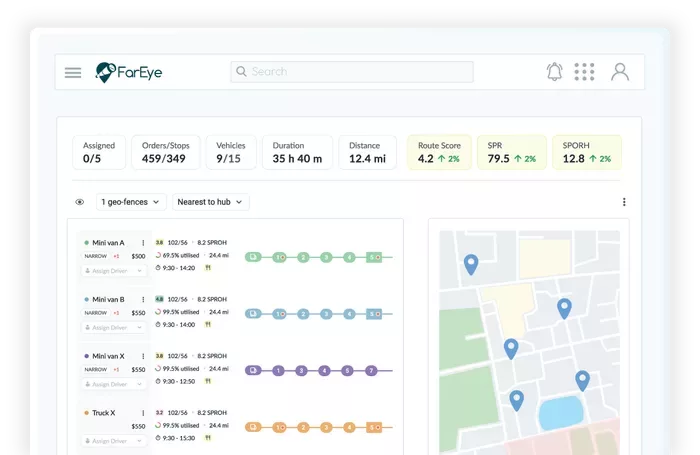- Route Optimization
Key Performance Metrics to Track in Route Optimization Software
Across American highways, city streets, and suburban avenues, logistics teams are racing against time not just to deliver packages but to deliver trust, consistency, and satisfaction. With US parcel volume set to reach over 30 billion pieces by 2030, the pressure on dispatchers and fleet managers to get routing right has never been higher. Every missed delivery window, every wasted mile, and every unplanned detour comes with a cost, sometimes in dollars, sometimes in customer loyalty.
For the professionals orchestrating these moving parts, the real story isn’t about trucks and packages. It’s about clarity, knowing which performance signals to watch, which metrics to trust, and how to turn vast streams of data into decisions that actually matter. That’s where effective route optimization software becomes more than a tool; it becomes the strategic nerve center of modern logistics.
Let’s explore the performance metrics that truly shape routing success and how today’s best software makes them actionable.

The Real Role of Route Optimization Software
At the heart of any logistics operation is a promise: “We’ll get it there when we said we would.” Fulfilling that promise takes more than good intentions and experienced drivers. It takes route optimization software that can handle the daily variables of traffic, weather, last-minute order surges, vehicle capacity limits, and the constant expectation for faster, more predictable delivery.
Modern routing optimization software does more than just plot the shortest path. It uses real-time data, predictive analytics, and AI-driven decision engines to dynamically adjust to shifting conditions. This makes tracking performance not just easier but more insightful.
Key Performance Metrics That Define Routing Optimization Success
Tracking the right metrics is essential to measure and improve the true impact of your route optimization software. Here are the core performance indicators that matter most in real-world logistics.
- On-Time Delivery Rate (OTD): The North Star of Routing
When logistics teams talk about performance, they’re often really talking about the on-time delivery rate. This metric measures the percentage of deliveries made within the customer’s promised window. It’s not just a vanity number; it’s the metric that most directly influences repeat business and contract renewals.
A strong OTD rate signals that your routing plans are working, your dispatch and driver teams are executing, and your software is adapting to daily reality. But as order density rises and delivery windows shrink, even a few missed deadlines can snowball into lost trust.
The most advanced route planning software integrates real-time traffic feeds, weather updates, and machine learning models to predict and correct possible delays, helping teams consistently keep this rate above 95%.
Formula:
On-Time Delivery Rate (OTD) = (Number of deliveries within promised window ÷ Total deliveries) × 100 - Route Adherence: Turning Plans Into Reality
No matter how sophisticated a routing plan is, it means little if drivers can’t or don’t stick to it. Route adherence measures how closely actual execution matches the planned sequence and timing of stops. Variations can result from last-minute order changes, customer requests, road closures, or simply human error.
Tracking this metric gives allocators insight into where plans are breaking down and where training, technology, or processes may need reinforcement. Modern routing optimization software leverages GPS tracking and geofencing to flag route deviations in real-time, making it possible to spot recurring trouble spots and address them before they impact OTD or fuel costs. - Average Delivery Time: Efficiency Beyond the Map
Every minute spent on the road is money spent on fuel, labor, and opportunity cost. Average delivery time (from departure to drop-off) is a core efficiency metric. By analyzing this across routes, locations, and times of day, dispatchers can identify patterns: Which zones are slow due to congestion? Which drivers consistently outperform? Which stops always take longer?
Smart route optimization software provides automated reporting, surfacing trends, and anomalies so managers can fine-tune routing logic or coach teams where it matters most. - Distance Traveled: The Foundation of Fleet Cost Control
Reducing distance traveled isn’t just about saving fuel; it’s about extending vehicle life, controlling overtime, and lowering the environmental footprint. Tracking total and per-route miles helps uncover inefficiencies that compound hundreds or thousands of daily trips.
Advanced AI-based routing software enables planners to minimize empty miles and optimize load balancing so every trip adds maximum value. Machine learning algorithms continuously refine routes based on actual delivery outcomes, not just historical averages, pushing efficiency gains further with each cycle. - First-Attempt Delivery Success Rate: The Hidden Cost Saver
A metric often overlooked, the first-attempt delivery success rate measures how often packages are delivered on the very first try. Missed deliveries result in costly re-attempts, lost driver productivity, and customer frustration.
Routing optimization software can boost this rate by considering customer preferences, delivery windows, and historical drop-off data when sequencing stops. AI-driven systems also automate real-time notifications, ensuring customers are ready when the driver arrives, cutting down on failed attempts.
Formula:
First-Attempt Delivery Rate = (Deliveries delivered on first attempt ÷ Total delivery attempts) × 100 - Vehicle and Driver Utilization Rates: Doing More With Less
Utilization metrics track how much of each vehicle’s and driver’s available time is spent on productive deliveries. Underutilized assets drain profits; overused ones risk burnout and breakdowns.
A high-performing routing optimization platform helps allocators balance workloads, avoid bottlenecks, and right-size fleets in response to real demand. Continuous visibility into these numbers means managers can quickly adjust schedules, reassign vehicles, or even rethink asset acquisition strategies. - Fuel Efficiency Per Route: Sustainability Meets Savings
With fluctuating fuel prices and growing sustainability mandates, fuel efficiency per route has moved from a back-office metric to a boardroom priority. By integrating telematics and vehicle data with route plans, routing optimization software enables granular measurement of fuel usage, making it easier to spot waste, monitor eco-driving initiatives, and justify investments in greener vehicles.
As fleets move toward electrification, these metrics will become even more central to operational planning and reporting. - Planned vs. Actual Route Comparison: The Learning Loop
Tracking the gap between planned and actual routes uncovers both the strengths and the blind spots in your routing strategy. Maybe your software’s time estimates are too optimistic for certain neighborhoods. Maybe certain customers regularly change instructions at the last minute.
By using these insights, managers can improve their routing rules, driver training, or even renegotiate delivery promises. AI-powered platforms automatically learn from these discrepancies, refining their algorithms to make the next day’s routes smarter. - Customer Experience Metrics: More Than a Delivery
Customers judge logistics by reliability, communication, and resolution of issues. Metrics like customer feedback scores, complaint rates, and average response time are crucial for understanding the impact of your routing strategy beyond operational numbers.
Top routing optimization software integrates customer notifications, proof-of-delivery, and feedback collection right into the delivery workflow, making it easier to monitor and improve the experience at every touchpoint. - Exception and Incident Reporting: Proactive Problem Solving
No routing plan survives contact with the real world. Accidents, delays, and exceptions will occur. Exception reporting metrics track frequency, type, and root causes of incidents, from traffic jams to vehicle breakdowns.
Armed with this data, logistics managers can implement targeted improvements, whether it’s adjusting delivery windows, adding contingency buffers, or upgrading fleet maintenance schedules.
Elevating Performance With AI-Based Routing Optimization
Not all route optimization software is created equal. FarEye’s AI-powered routing solutions do more than just automate what was previously manual. They learn from every delivery, adapt to changes in real-time, and surface the right metrics exactly when and where they matter.
By combining machine learning, predictive analytics, and seamless integration with existing systems, FarEye empowers dispatchers and allocators to see not just what’s happening but why and what should happen next. This is the new standard for fleet efficiency: not just reacting to yesterday’s challenges but anticipating tomorrow’s.
Choosing Metrics That Matter
For today’s logistics professionals, tracking the right performance metrics isn’t just a reporting task; it’s the key to staying agile, competitive, and customer-focused. As volumes grow and expectations rise, the organizations that win will be those that use every delivery, every route, and every data point to get better, faster, and smarter.
With the right AI-powered routing optimization software, these KPIs become more than numbers; they become your blueprint for operational excellence. Get an ROI model for your fleet. Request a personalized route optimization KPI baseline today.
FAQs
- What is the most important KPI for route optimization software?
On-Time Delivery (OTD) is widely considered the most important KPI because it directly impacts customer trust, repeat business, and service contracts. - How is route optimization ROI measured?
ROI is typically measured through reductions in total miles driven, labour hours saved, improved On-Time-In-Full (OTIF) rates, and gains in first-attempt delivery success. - What data sources do I need to track these KPIs?
Key data inputs include order feeds from OMS/TMS, telematics and GPS pings, driver schedules, and proof-of-delivery events.
Source:

Komal Puri is a seasoned professional in the logistics and supply chain industry. As the AVP of Marketing and a subject matter expert at FarEye, she has been instrumental in shaping the industry narrative for the past decade. Her expertise and insights have earned her numerous awards and recognition. Komal’s writings reflect her deep understanding of the industry, offering valuable insights and thought leadership.
Let's Talk to Our Experts and Optimize Your Deliveries Today!
An expert from our team will reach out within 24 hours



